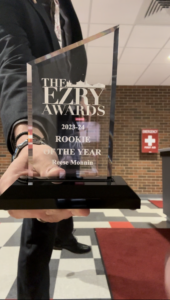Wittenberg history professor Darlene Brooks Hedstrom spent a good portion of her past semester studying the kitchens of ancient monasteries as part of her Feeding Asceticism project.
Brooks Hedstrom, taking the first half of a year-long sabbatical during spring semester of the 2014-2015 academic school year, gave a colloquium on the five projects that she worked on during her time away from Wittenberg.
The colloquium, entitled “Savoring Sabbatical: Eating, Dining and the Archeology of Monastic Sites,” was held in Founders Pub at 4 p.m. on Sept. 17. About 30 students and faculty members attended.
“I typically don’t look into that era of history, but it was interesting to see how much [Brooks Hedstrom] was able to find just about monastic kitchens,” Melissa Newman, ’16, said.
Beginning the colloquium by refuting the “sloth theory” that professors spend their sabbaticals napping and watching Netflix, Brooks Hedstrom spent much of the presentation talking about her fellowship in Byzantine Studies at Dumbarton Oaks.
 Dumbarton Oaks, a part of Harvard University in a district of Washington D.C., is an international research institute that houses a library and collection of Byzantine, Garden and Landscape, and Pre-Columbian studies.
Dumbarton Oaks, a part of Harvard University in a district of Washington D.C., is an international research institute that houses a library and collection of Byzantine, Garden and Landscape, and Pre-Columbian studies.
Brooks Hedstrom’s area of focus is Byzantine studies, which focuses on the Byzantine Empire, the predominantly Greek-speaking continuation of the eastern part of the Roman Empire during late antiquity and the middle ages.
One of Brooks Hedstrom’s projects that focused predominantly on the ancient monasteries during the Byzantine Empire was an examination of kitchens and bakehouses in monastery buildings.
Her interest in these structures was furthered by her “excavation” work during her first sabbatical with the Yale Monastic Archaeology Project at John the Little in Wadi Natrun, Egypt, which uncovered several kitchen facilities within a monastic dwelling or residence that other residences at the time did not contain.
She then began to examine the presence of similar features at other monastic sites, most of which date from the sixth through ninth centuries C.E.
“While it is not a ‘new’ discovery of the kitchens as features, my work is the first one to put kitchens and bakehouses at the center as a lens for looking at monastic life in Egypt,” Brooks Hedstrom said. “My research at Dumbarton Oaks allowed me vital time to then expand my research into areas outside of Egypt, and to consider the regional variation of the monastic kitchen and bakehouse.”
Much of her research, involving image collection and fieldwork, enabled Brooks Hedstrom to not only uncover the archeology and customs of monastic cooking, but also to discover regional differences between monasteries in different geographical areas.
“It’s a myth that monks are starving themselves and that they are malnourished,” Brooks Hedstrom said.
Her findings are to be published by Cambridge University Press in a book entitled “The Monastic Landscape of Late Antique Egypt: An Archaeological Reconstruction.”
Other projects that Brooks Hedstrom undertook during her sabbatical were speaking at other universities, processing data from her field work through the Yale Monastic Archeology Project in Egypt, further studying the works of Jacob Abbott and working on completing her manuscript.
Brooks Hedstrom plans to travel to Cairo, Egypt for the second half of her sabbatical in three years.







